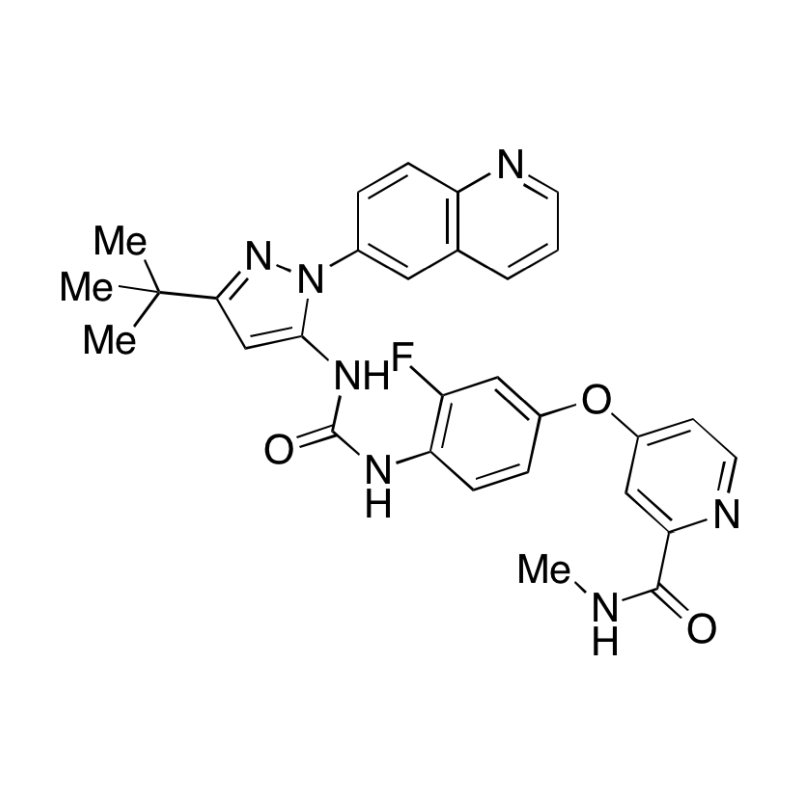产品
编 号:F010405
分子式:C30H28FN7O3
分子量:553.59
分子式:C30H28FN7O3
分子量:553.59
产品类型
规格
价格
是否有货
10mM*1mL in DMSO
询价
询价
1mg
询价
询价
5mg
询价
询价
10mg
询价
询价
50mg
询价
询价
结构图

CAS No: 1020172-07-9
产品详情
生物活性:
Rebastinib (DCC-2036) is an orally active, non-ATP-competitive?Bcr-Abl inhibitor for Abl1WT and Abl1T315I with IC50s of 0.8 nM and 4 nM, respectively. Rebastinib also inhibits SRC, KDR, FLT3, and Tie-2, and has low activity to seen towards c-Kit.
体内研究:
A single dose of Rebastinib (DCC-2036; oral; 100 mg/kg)affords circulating plasma levels that exceeds 12 μM for up to 24 hours, and effectively inhibits BCR-ABL1 signaling for up to 8 hours in Ba/F3-BCR-ABL1T315I leukemia cells isolated from BM and spleen of tumor-bearing mice.Treatment of mice bearing Ba/F3-BCR-ABL1T315I leukemia cells with Rebastinib at 100 mg/kg once daily by oral gavage significantly prolonged their survival, while STI571 at 100 mg/kg twice daily is ineffective.In this aggressive allograft model, Rebastinib is as effective for treatment of BCR-ABLT315I leukemia as STI571 at 100 mg/kg twice daily in BCR-ABL1native leukemia, and reduces the leukemia cell burden in the spleens of treated mice.
体外研究:
Rebastinib potently (IC50 0.82 nM) inhibits u-ABL1native, which is thought to exist predominantly in the inactive type II conformation. In addition, Rebastinib also strongly inhibits p-ABL1native (IC50 2 nM), which more readily adopts an active, Type I conformation. Rebastinib potently inhibits both u-ABL1T315I (IC50 5 nM) and p-ABL1T315I (IC50 4 nM), both of which exist predominately in the Type I conformation due to stabilization of an activating hydrophobic spine by the T315I mutation.In addition to ABL1, Rebastinib also inhibits the SRC family kinases LYN, SRC, FGR, and HCK, and PDGFRα, and PDGFRβ with IC50 of 29±1, 34±6, 38±1, 40±1, 70±10 and 113±10 nM, respectively. Notably, Rebastinib spared c-KIT (IC50 481 nM).Rebastinib effectively inhibits the proliferation of Ba/F3 cells expressing native BCR-ABL1native (IC50 5.4 nM). Rebastinib also inhibits proliferation of the Ph+ cell line K562 (IC50 5.5 nM). Rebastinib also inhibits proliferation of several common TKI-resistant mutants of BCR-ABL1, including G250E, Q252H, Y235F, E255K, V299L, F317L, and M351T, at IC50s ranging from 6-150 nM. Rebastinib effectively inhibits autophosphorylation of BCR-ABL1native (IC50 29 nM) and BCR-ABL1T315I (IC50 18 nM), as well as the phosphorylation of STAT5 in both cell lines (IC50 28 nM and 13 nM, respectively).
Rebastinib (DCC-2036) is an orally active, non-ATP-competitive?Bcr-Abl inhibitor for Abl1WT and Abl1T315I with IC50s of 0.8 nM and 4 nM, respectively. Rebastinib also inhibits SRC, KDR, FLT3, and Tie-2, and has low activity to seen towards c-Kit.
体内研究:
A single dose of Rebastinib (DCC-2036; oral; 100 mg/kg)affords circulating plasma levels that exceeds 12 μM for up to 24 hours, and effectively inhibits BCR-ABL1 signaling for up to 8 hours in Ba/F3-BCR-ABL1T315I leukemia cells isolated from BM and spleen of tumor-bearing mice.Treatment of mice bearing Ba/F3-BCR-ABL1T315I leukemia cells with Rebastinib at 100 mg/kg once daily by oral gavage significantly prolonged their survival, while STI571 at 100 mg/kg twice daily is ineffective.In this aggressive allograft model, Rebastinib is as effective for treatment of BCR-ABLT315I leukemia as STI571 at 100 mg/kg twice daily in BCR-ABL1native leukemia, and reduces the leukemia cell burden in the spleens of treated mice.
体外研究:
Rebastinib potently (IC50 0.82 nM) inhibits u-ABL1native, which is thought to exist predominantly in the inactive type II conformation. In addition, Rebastinib also strongly inhibits p-ABL1native (IC50 2 nM), which more readily adopts an active, Type I conformation. Rebastinib potently inhibits both u-ABL1T315I (IC50 5 nM) and p-ABL1T315I (IC50 4 nM), both of which exist predominately in the Type I conformation due to stabilization of an activating hydrophobic spine by the T315I mutation.In addition to ABL1, Rebastinib also inhibits the SRC family kinases LYN, SRC, FGR, and HCK, and PDGFRα, and PDGFRβ with IC50 of 29±1, 34±6, 38±1, 40±1, 70±10 and 113±10 nM, respectively. Notably, Rebastinib spared c-KIT (IC50 481 nM).Rebastinib effectively inhibits the proliferation of Ba/F3 cells expressing native BCR-ABL1native (IC50 5.4 nM). Rebastinib also inhibits proliferation of the Ph+ cell line K562 (IC50 5.5 nM). Rebastinib also inhibits proliferation of several common TKI-resistant mutants of BCR-ABL1, including G250E, Q252H, Y235F, E255K, V299L, F317L, and M351T, at IC50s ranging from 6-150 nM. Rebastinib effectively inhibits autophosphorylation of BCR-ABL1native (IC50 29 nM) and BCR-ABL1T315I (IC50 18 nM), as well as the phosphorylation of STAT5 in both cell lines (IC50 28 nM and 13 nM, respectively).
产品资料

